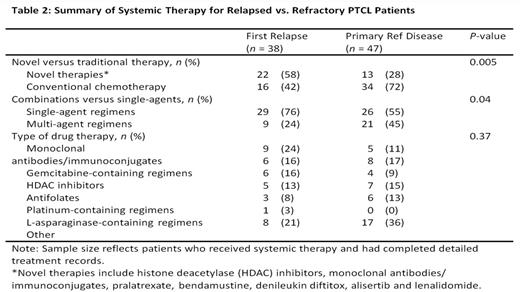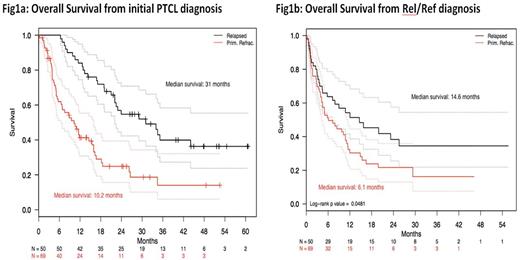Abstract
Introduction: Outcomes for patients with aggressive T cell lymphomas who are not cured by frontline therapies are poor. A Canadian retrospective analysis showed median overall survival (OS) to be 6.5 months combined for peripheral T-cell lymphoma (PTCL) patients in first relapse (Rel) and patients with primary refractory (Ref) disease (Mak, et al. JCO 2013). There have been no prospective studies that have examined the differences between Rel and Ref patients. In this analysis, we examined clinical features and outcomes for 285 patients prospectively enrolled in the COMPLETE Registry who completed frontline therapy and identified 119 patients with either Rel or Ref disease. We describe differences in clinical features, treatment, and outcomes between Rel and Ref patients.
Methods: Patients with all subtypes of PTCL from 72 sites in the US were prospectively enrolled in the COMPLETE registry at initial diagnosis. Clinical and histopathologic features, treatment regimens, goals of therapy, toxicities, and outcomes were recorded. For this analysis, Ref disease was defined as no response to initial treatment or progression during or within 1 month of completing frontline therapy. Rel disease was defined as progression at least 1 month from completion of frontline therapy in patients who achieved a complete response (CR) or partial response (PR).
Results: Of 285 patients in COMPLETE who had locked treatment and follow-up records required for this analysis, 50 met the criteria for Rel and 69 for Ref PTCL. Demographics (age, gender, race) and key clinical characteristics at initial diagnosis (histology [Table 1], bone marrow involvement, LDH, ECOG performance status) did not significantly differ between Rel and Ref patients. According to the treating physician, the primary goal of second-line therapy was cure in over half of both groups (52% for Rel, 60% for Ref); the remainder were managed with palliative intent. Rel patients received novel therapies (see Table 2 for definition) more frequently than Ref patients (58% vs. 28%) (P = 0.005) and were less likely to receive multi-agent regimens (24% vs. 45%; P = 0.04) [Table 2]. In the 55 Rel and Ref patients who received single-agent therapy, the most common agents were brentuximab vedotin (20%), romidepsin (15%), pralatrexate (9%) and gemcitabine (7%). In the 30 patients who received multi-agent therapy, the most common regimens were ICE (ifosfamide, carboplatin and etoposide) (17%), GemOx (gemcitabine and oxaliplatin) (17%), and CHOP or CHOP-like plus etoposide (13%). Despite similar frontline therapy with combination chemotherapy regimens, more Rel patients underwent high dose therapy and transplant compared to the Ref group (30% vs. 4%; P = 0.0005). Although single agent versus combination therapy showed similar objective response rates (ORR= CR+PR), the ORR of novel vs. traditional chemotherapy showed a trend favoring novel agents for the entire cohort (57% vs. 38%; P = 0.07). The ORR to second-line therapy was higher in Rel patients (63% vs. 38%; P = 0.02) as was the proportion achieving a CR (38% vs. 15%; P = 0.02). Further, Rel patients had longer OS compared Ref patients, with a median OS of 31 months (95% CI: 22.1 months to not reached) versus 10.2 months (95% CI: 6.5 - 15.9 months) from first diagnosis (Figure 1a) and 14.6 months versus 6.1 months (P = 0.048) from the time of relapse or progression (Figure 1b). For both Rel and Ref patients, there was no difference in survival by PTCL subtype. In both the Rel group and Ref groups, survival was significantly longer in patients treated with curative vs. palliative (as determined by the treating physician) intent (P = 0.01).
Conclusions: Our analysis of real world outcomes in patients with aggressive T cell lymphomas demonstrates that outcomes are significantly worse for patients with Ref compared to those with Rel disease. Interestingly, novel single agent therapies were used most often as second-line therapy in Rel patients while multi-agent chemotherapy was used more frequently in Ref patients, despite the demonstration of activity of novel single agents in the Ref setting in other studies. The high proportion of patients with Rel or Ref disease in COMPLETE, and the demonstrated activity of novel agents in the Rel and Ref settings, supports initiatives to incorporate novel agents into frontline therapy for PTCL.
Lansigan:Spectrum: Consultancy, Research Funding; Pharmacyclics: Consultancy; Teva: Research Funding; Celgene: Consultancy. Horwitz:Huya: Consultancy; Celgene: Consultancy; Takeda: Consultancy, Research Funding; Infinity: Consultancy, Research Funding; Bristol-Myers Squibb: Consultancy; Kyowa Hakka Kirin: Consultancy, Research Funding; Spectrum: Consultancy, Research Funding; Seattle Genetics: Consultancy, Research Funding; ADCT Therapeutics: Research Funding. Pinter-Brown:Celgene: Consultancy; Spectrum Pharmaceuticals: Consultancy; Seattle Genetics: Consultancy. Carson:American Cancer Society: Research Funding. Pro:Seattle Genetics: Honoraria; Takeda: Honoraria; Celegene: Honoraria. Hsi:Onyx Pharmaceuticals: Honoraria; Seattle Genetics: Honoraria; Eli Lilly: Research Funding; Cellerant: Honoraria, Research Funding; Abbvie: Honoraria, Research Funding; HTG Molecular Diagnostics: Consultancy. Federico:MedNet Solutions: Consultancy. Gisselbrecht:Roche/Genentech: Research Funding, Speakers Bureau. Schwartz:MedNet Solutions: Employment. Bellm:Merck: Equity Ownership; Johnson & Johnson: Equity Ownership; BMS: Equity Ownership; MedNet Solutions: Consultancy, Other: Reimbursement of travel-related expenses. Acosta:Spectrum Pharmaceuticals: Employment, Equity Ownership. Foss:Celgene: Consultancy, Research Funding, Speakers Bureau; Seattle Genetics: Consultancy, Speakers Bureau; Spectrum Pharmaceuticals: Consultancy; Eisai: Consultancy.
Author notes
Asterisk with author names denotes non-ASH members.




This feature is available to Subscribers Only
Sign In or Create an Account Close Modal